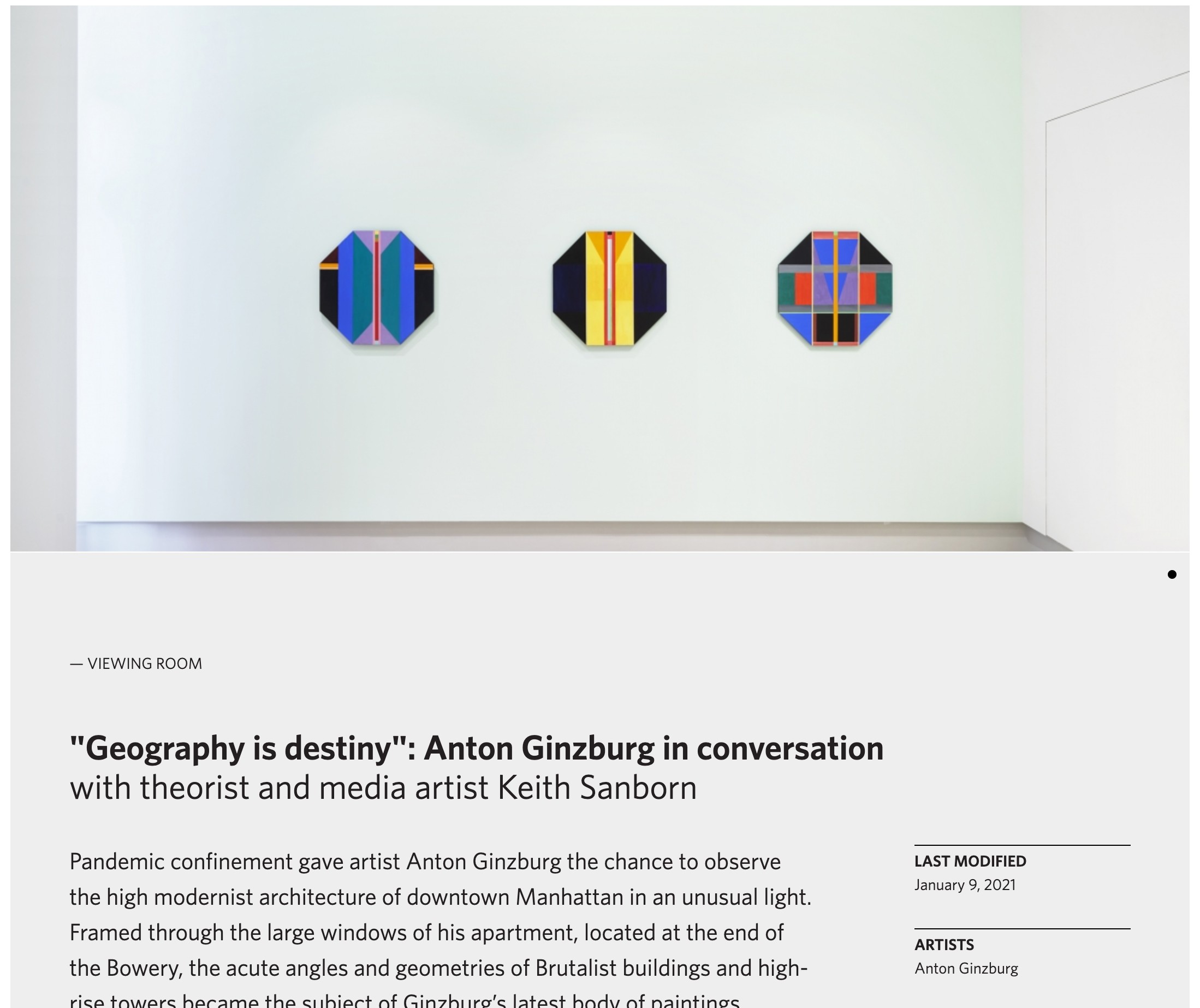
https://helwasergallery.com/viewing_room/in-conversation-anton-ginzburg-with-keith-sanborn/
On the occasion of Anton Ginzburg's second solo exhibition with Helwaser Gallery, we are pleased to announce a conversation between artist Anton Ginzburg and theorist and media artist Keith Sanborn.
Pandemic confinement gave Ginzburg the chance to observe the high modernist architecture of downtown Manhattan in an unusual light. Framed through the large windows of his apartment, located at the end of the Bowery, the acute angles and geometries of Brutalist buildings and high-rise towers became the subject of Ginzburg’s latest body of paintings. Entitled Translucent Concrete, the series serves as an abstract record of Ginzburg’s impressions of interior and exterior scenes that he observed during time spent indoors, or on walks through the deserted neighborhood.
In this interview, Ginzburg and Sanborn discuss the links between this latest series of paintings and the ideals of the Situationist International. They explore Ivan Chtcheglov's manifesto, "Formulary for a New Urbanism", which served as an intellectual influence for Translucent Concrete, and the changing realities of urban living today.
READ
Included below is an excerpt from their conversation:
KS: Your newest works bear connections with some of the earliest interests of the Situationist International. In particular, they emphasized the relationship of people to the urban milieu, and what they called psychogeography. The pandemic has caused a radical alteration in this relationship.
AG: Staying at home during a pandemic made me think about my immediate environment and the modernist architecture I was surrounded by. The building I currently live in is Chatham Tower in downtown New York, a brutalist tower built in 1969. That era was characterized by the threat of the nuclear war with the Soviet Union during the Cold War — the proportions, tectonics, and aesthetic choices remind me of a massive bomb shelter. Staying quarantined indoors, I turned to reading the manifesto published by the Situationist International, entitled “Formulary for a New Urbanism, 1959”, which had been written by Ivan Chtcheglov. I found some interesting coincidences; when he writes about modernist architecture (for example, Le Corbusier buildings), he states that they arouse in him the idea of immediate suicide. That is, that the last remnants of joy were destroyed. And as it happens, I live right across the street from the prison where Jeffrey Epstein recently committed suicide.
.....
Keith Sanborn is a media artist, theorist and translator based in New York. His artistic practice includes film, video, photography, installation, and performance. That work has been the subject of numerous one-person shows and has been featured in major museum surveys including the Whitney Biennial, the American Century, and Monter/Sampler (Centre Pompidou) and festivals including EMAF, OVNI, and The Rotterdam International Film Festival. He has curated programs for Artists Space (New York), the Oberhausen Short FilmFestival, and Hallwalls Gallery, among others. He has taught at Princeton University, Columbia University, Bard College, UCSD, SUNY, Buffalo and the San Francisco Art Institute. His theoretical work has appeared in journals, books, and museum catalogues. He has translated the work of Debord, Viénet, Wolman, Bataille, Napoleon, Gioli, Brecht, Farocki, Kuleshov and Shub.
Translation best describes his work as a whole: the strategic shift of media from one context to another.

